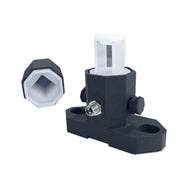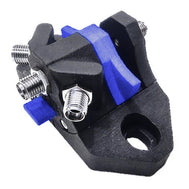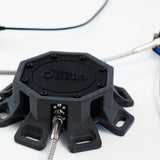Choosing a Sample Holder for Spectroscopy

To measure the optical properties of a sample, either it will need to be:
- Deposited into a thin film OR
- Suspended in solution
Each of these approaches come with their advantages and limitations, and both measurements will be affected by different things. One question to consider is should you measure your samples as a thin film or in solution? This decision will depend on the type of measurement you are taking, your sample and its desired application.
Do You Need a Sample Holder for Spectroscopy?
In short, yes.
A designated sample holder is one of the most important pieces of equipment you need in spectroscopy. Sample holders enable you to properly position the sample for analysis, ensuring alignment is maintained and measurements are consistent. Dedicated holders allow for accurate measurement of the entire sample while preventing any blockage of the beam. Fixed sample holders will also protect the sample from vibration or temperature changes during analysis, thus eliminating possible sources of measurement errors. Put simply, if you can fix your sample in place, this makes everything so much easier.
Ossila sell sample two sample holders:
- One which is compatible with standard size cuvettes.
- One can hold thin film substrates of any width.
Both of these allow for different positioning of inlet and outlet light, so they can be used for a range of optical measurements.

Cuvette Holder
The Ossila Cuvette Holder is compatible with standard 10 mm path length cuvettes including our UV Quartz Cuvettes and IR Quartz Cuvettes. These can be fixed to our Ossila Optical Breadboard.
Suitable for measurements on solutions including:
- Photoluminescence measurements
- Absorbance measurements

Spectroscopy 4-port Transmission Holder
The Ossila Spectroscopy Transmission Holder uses a compression mechanism to secure substrates in a vertical position. The 4-port version additionally allows for maximum adaptability in the measurements you can do.
Suitable for measurements on rigid or flexible thin films including:
- Photoluminescence measurements
- Absorbance measurements
The Ossila Optical Spectroscopy Kit includes both of these substrate holders to allow you to be adaptable in both the measurements you take and the samples that you measure.
Why Use Quartz Glass Cuvettes and Substrates?
Whether your samples are liquids or thin films, you will need to use substrates or cuvettes which transmit light in the UV-Vis region. Quartz glass has very high transmission rates in the visible region and this extends down into the UV.
Optical Spectrometer

Learn More...
 Choosing A Light Source For Your Spectrometer
Choosing A Light Source For Your Spectrometer
Depending on your spectrometer application, you will probably need at least one illumination or excitation source. For electroluminescence measurements will require of some sort of testing board connected to an external voltage source. However, most characterisation of optical materials require some sort of incident light.
Read more... Measuring Thin Film Fluorescence
Measuring Thin Film Fluorescence
Measuring fluorescence (or photoluminescence) with the Ossila Optical Spectrometer will allow you to detect light emission from your sample between 360 nm - 1000 nm. You can use optical spectroscopy as a quick and easy way to characterise fluorescence from your sample. However, you will need an integrating sphere or a more complex system if you want to measure quantitative measurements such as PLQY.
Read more...